July 31st, 2010 |
Published in
Football Card Oddities | 2 Comments
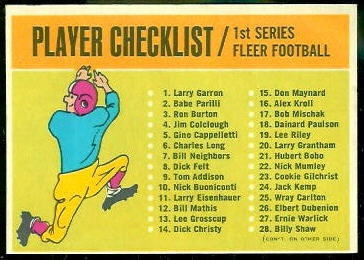 Last week, on my Facebook page, Pastor Scott asked if I knew if Fleer had planned a second series of football cards in 1963, since the 1963 checklist says “1st SERIES.” I told Scott that I had not noticed the label before, but that it was reasonable to surmise that Fleer had planned another series. Fleer printed two series in 1961–one of NFL players and one of AFL players–and perhaps the company had hopes of doing the same in 1963. (For more on Fleer’s early 1960s football cards, see F is for Fleer.)
Last week, on my Facebook page, Pastor Scott asked if I knew if Fleer had planned a second series of football cards in 1963, since the 1963 checklist says “1st SERIES.” I told Scott that I had not noticed the label before, but that it was reasonable to surmise that Fleer had planned another series. Fleer printed two series in 1961–one of NFL players and one of AFL players–and perhaps the company had hopes of doing the same in 1963. (For more on Fleer’s early 1960s football cards, see F is for Fleer.)
The 1963 checklist is also curious for other reasons:
-
It’s the first and only checklist that Fleer printed in its four years of producing football cards.
-
It is the only card in the 1963 set that is not numbered.
-
On an uncut sheet, the player cards were in a predictable order, by number, but the checklist was stuck in the middle, displacing two of the player cards. (You can see this on my virtual uncut 1963 Fleer sheet.)
-
It is a short print (and so are the two cards it displaced on the sheet).
-
It is orange and green, though the base color of the player cards is red. Checklists typically have the same color scheme as the rest of the set.
To me, it looks like a new Fleer manager came in just before production and said, “Hey, Topps has checklists, so we need to throw one in there, too. And maybe we’ll have a second series, so put ‘first series’ on it.” And then they left the kiddies hanging.
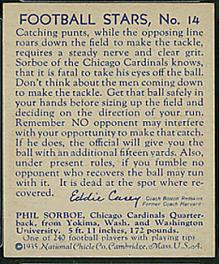 Fleer wasn’t the only company that had football card plans grander than they could execute. As I wrote in N is for National Chicle, the backs of 1935 National Chicle cards say “one of 240 football players with playing tips,” but there are only 36 cards in the set. There were only eight pro teams at the time, so 240 cards would have covered practically every player in the league. As I said in the article, I suspect that the company planned to include college players and coaches in their set, as well.
Fleer wasn’t the only company that had football card plans grander than they could execute. As I wrote in N is for National Chicle, the backs of 1935 National Chicle cards say “one of 240 football players with playing tips,” but there are only 36 cards in the set. There were only eight pro teams at the time, so 240 cards would have covered practically every player in the league. As I said in the article, I suspect that the company planned to include college players and coaches in their set, as well.
July 29th, 2010 |
Published in
Silly Stuff, Uniforms
July 28th, 2010 |
Published in
Football Card Oddities
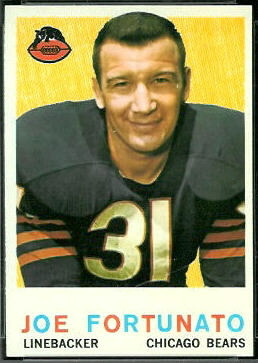 Last week a reader asked me why there aren’t any Chicago Bears in the first series of 1959 Topps football cards. My expert answer was, “Huh, I never noticed that.” But the reader was right: the 1959 Topps first series cards are numbered 1 through 88, and the Bears cards are all numbered 90 and higher. Topps compensated by putting eleven Bears in the 88-card second series, but, over the whole set, the Bears are still outnumbered by every other team.
Last week a reader asked me why there aren’t any Chicago Bears in the first series of 1959 Topps football cards. My expert answer was, “Huh, I never noticed that.” But the reader was right: the 1959 Topps first series cards are numbered 1 through 88, and the Bears cards are all numbered 90 and higher. Topps compensated by putting eleven Bears in the 88-card second series, but, over the whole set, the Bears are still outnumbered by every other team.
Imagine being a young Bears fan, spending all of your paper route money on a stack of wax packs, and not getting any cards of your favorite team! Why might the Bears have been omitted? Did they send their photos to Topps too late to make the first series? Did Topps forget that Chicago had two teams? My guess is that Topps and the Bears had some sort of contract problem, but that’s only a guess. If anyone else has more information, please let me know.
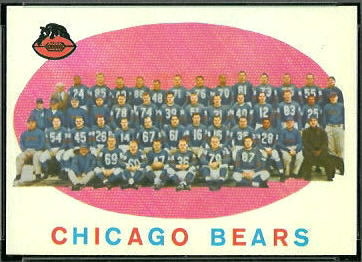 Ironically, the Bears team card is one of the three easiest 1959 Topps cards to find in high grade, the others being the Giants and Steelers team cards. All three cards are in the second series, which appears to have been printed in greater quantities than the first series. (This is unusual: Topps typically printed the earlier series in greater numbers.) All three were also in the interior of the full sheet (see my virtual uncut 1959 Topps sheet), so they were less susceptible to damage in production than cards on the edge of the sheet. And, finally, I think that the team cards’ oval interior design makes them more forgiving of cutting problems. The other cards in the set–namely the player and team pennant cards–have rectangular interiors, making off-centering and diamond cuts more obvious.
Ironically, the Bears team card is one of the three easiest 1959 Topps cards to find in high grade, the others being the Giants and Steelers team cards. All three cards are in the second series, which appears to have been printed in greater quantities than the first series. (This is unusual: Topps typically printed the earlier series in greater numbers.) All three were also in the interior of the full sheet (see my virtual uncut 1959 Topps sheet), so they were less susceptible to damage in production than cards on the edge of the sheet. And, finally, I think that the team cards’ oval interior design makes them more forgiving of cutting problems. The other cards in the set–namely the player and team pennant cards–have rectangular interiors, making off-centering and diamond cuts more obvious.
July 27th, 2010 |
Published in
Player Deaths | 1 Comment
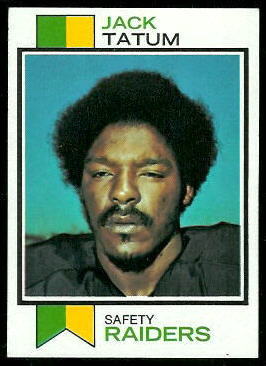 Jack Tatum, who played safety for ten seasons with the Oakland Raiders and Houston Oilers, passed away today. Tatum was a three-time Pro Bowler and a member of the Raiders team that won the Super Bowl in 1976. He was also a member of two national championship teams at Ohio State, and he was inducted into the College Football Hall of Fame in 2004. His obituary on the ESPN web site includes a recent photo.
Jack Tatum, who played safety for ten seasons with the Oakland Raiders and Houston Oilers, passed away today. Tatum was a three-time Pro Bowler and a member of the Raiders team that won the Super Bowl in 1976. He was also a member of two national championship teams at Ohio State, and he was inducted into the College Football Hall of Fame in 2004. His obituary on the ESPN web site includes a recent photo.
Pictured here is Tatum’s rookie card, a 1973 Topps. He appeared on numerous cards after 1973, as well. You can see Tatum’s early cards in the Vintage Football Card Gallery, and you can find his later cards on eBay.
July 27th, 2010 |
Published in
Football Card Trivia, Interactive Team Cards, New in the Gallery, Sites I Like
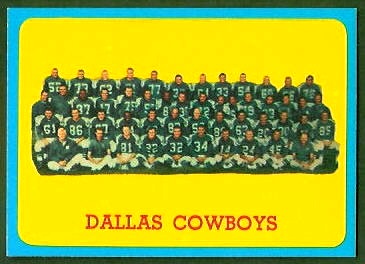 Yesterday I added an “interactive” 1963 Topps Dallas Cowboys team card to the Vintage Football Card Gallery. By placing the cursor over a player, you can see who the player is, and by clicking on him, you can see all of his cards. (It doesn’t work on the card pictured here–you have to go to the gallery page.) As the gallery page says, this 1963 card actually pictures the 1960 Cowboys team, and only eight of the players were still with the team when the card was issued.
Yesterday I added an “interactive” 1963 Topps Dallas Cowboys team card to the Vintage Football Card Gallery. By placing the cursor over a player, you can see who the player is, and by clicking on him, you can see all of his cards. (It doesn’t work on the card pictured here–you have to go to the gallery page.) As the gallery page says, this 1963 card actually pictures the 1960 Cowboys team, and only eight of the players were still with the team when the card was issued.
The Cowboys were an expansion team in 1960, and they obtained most of their players from the other teams via an expansion draft. Each of the other teams made nine players available, and the Cowboys chose three of them. Like the other teams, the Cowboys also obtained players via trades, free agency, and other teams’ waiver lists. Unfortunately, the league approved the franchise too late for the Cowboys to participate in the college draft, and the team also had to compete with the upstart AFL for free agents. The result: a 0-11-1 season.
To see how the Cowboys assembled their original team, check out The Original 1960 Dallas Cowboys Roster at thecowboysguide.com. The page includes pictures of the team-issued photos for most of the players, and it also shows many of the players’ first cards. Very interesting!
July 26th, 2010 |
Published in
Football Card Trivia | 1 Comment
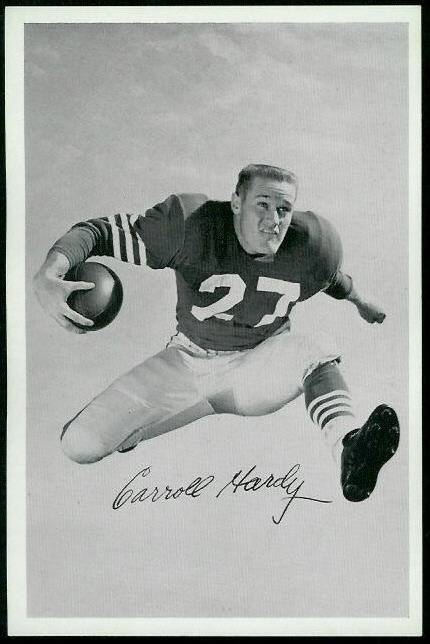 I have always loved this photo of Carroll Hardy, and yesterday I did an eBay search to see if I could find him on any more 49er team issues. To my surprise, a bunch of baseball cards popped up! Not being a baseball card collector, I didn’t know that after a short NFL career, Hardy had played eight seasons in the major leagues. Perhaps, conversely, most baseball card collectors don’t know about his short NFL career?
I have always loved this photo of Carroll Hardy, and yesterday I did an eBay search to see if I could find him on any more 49er team issues. To my surprise, a bunch of baseball cards popped up! Not being a baseball card collector, I didn’t know that after a short NFL career, Hardy had played eight seasons in the major leagues. Perhaps, conversely, most baseball card collectors don’t know about his short NFL career?
According to his Wikipedia page, Hardy spent just one year with the 49ers, 1955, when this 49ers team issue photo was released. He gained 37 yards rushing and 338 yards receiving for the season, and four of his receptions were for touchdowns.
He went on, after two years in the minor leagues, to become a backup outfielder for the Cleveland Indians, Boston Red Sox, Houston Colt .45s, and Minnesota Twins. He was the only player to pinch-hit for Ted Williams, and he also pinch-hit for Roger Maris and Carl Yastrzemski.
You can see the rest of the 1955 49ers Team Issue photos in the Vintage Football Card Gallery.
July 21st, 2010 |
Published in
Halls of Fame
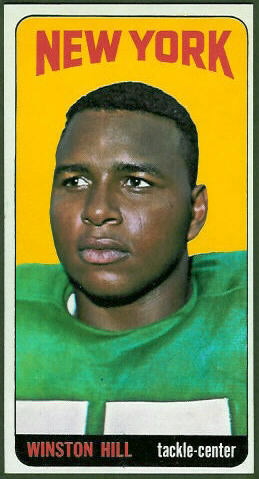 The New York Jets announced yesterday that their new stadium, New Meadowlands Stadium, will include a Jets Ring of Honor. The Jets chose five former players and a former coach as the first inductees. Here are the inductees, along with information on their cards:
The New York Jets announced yesterday that their new stadium, New Meadowlands Stadium, will include a Jets Ring of Honor. The Jets chose five former players and a former coach as the first inductees. Here are the inductees, along with information on their cards:
- Weeb Ewbank – Ewbank coached the Jets from 1963 to 1973; before that he coached the Baltimore Colts from 1954 to 1962. I don’t believe Ewbank appeared by himself on a card in his coaching days, but he did appear on some of the Colts team cards (he’s named on the 1956 Topps card), and probably on the 1964 Topps Jets team card–if Topps didn’t use an old photo. It’s usually hard to pick out coaches on team cards, unfortunately, since the coaches don’t wear numbers. Ewbank did appear on some cards in tribute sets in the 1980s and later, though. You can find a lot of the tribute cards on eBay.
- Winston Hill – Hill’s rookie card is the 1965 Topps card pictured here, and he also appeared on a bunch of cards after that. You can see most of Hill’s cards in the Vintage Football Card Gallery.
- Joe Klecko – Klecko’s rookie card is a 1978 Topps, and he appeared on a lot of cards in the 80s. As I wrote in an earlier post, I once bought a bunch of his rookie cards from Teletrade, and I sold them recently for next to nothing. Will they jump in price now that he’s in the Ring of Honor? Probably not. You can find most of Klecko’s cards on eBay.
- Curtis Martin – Martin appeared on a billion cards between 1995 and 2006. I don’t handle modern cards, so I’m afraid I can’t say much about them. You can find a nice selection on eBay.
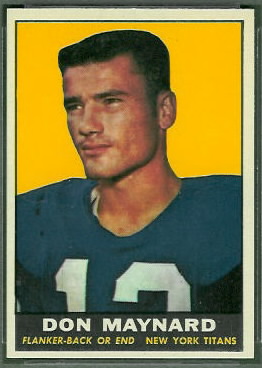
- Don Maynard – Maynard has two rookie cards, a 1961 Topps (pictured here) and a 1961 Fleer, and he appeared on cards every year through his last season, 1973. (His 1973 Topps card has him still with the Jets, but he played for the Cardinals that season.) You can see most of Maynard’s cards in the Vintage Football Card Gallery.
- Joe Namath – Namath’s rookie card, a 1965 Topps, is one of the most familiar cards in the hobby. (See J is for Joe Namath–and the 1965 Topps Tall Boys.) From 1965 to 1973, he appeared on numerous regular issue cards, oddballs, and inserts. Oddly, though he was still playing, he did not appear on any cards from 1974 to 1977. After he retired, he appeared on cards in a lot of tribute sets. You can see most of Namath’s cards from his playing days in the Vintage Football Card Gallery, and a lot of the rest on eBay.
July 21st, 2010 |
Published in
Football Card Trivia, Interactive Team Cards, New in the Gallery
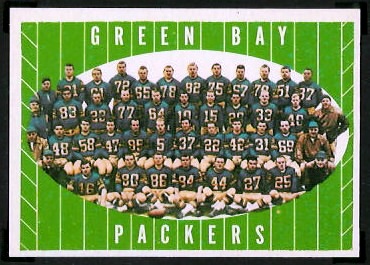 Yesterday I added an “interactive” 1961 Topps Packers Team Card to the Vintage Football Card Gallery. By placing the cursor over a player, you can see who the player is, and by clicking on him, you can see all of his cards. (It doesn’t work on the card pictured here–you have to go to the gallery page.)
Yesterday I added an “interactive” 1961 Topps Packers Team Card to the Vintage Football Card Gallery. By placing the cursor over a player, you can see who the player is, and by clicking on him, you can see all of his cards. (It doesn’t work on the card pictured here–you have to go to the gallery page.)
In the process of looking up the players, I learned a few things:
- Ray Nitschke wore number 33 in his rookie season.
- Hall of Famer Len Ford spent the last year of his career with the Packers.
- Billy Kinard was a Packer before joining the AFL’s Buffalo Bills in 1960.
- Steve Meilinger appeared on a 1958 Topps card with the Redskins, but he actually played for the Packers that year.
- Joe Johnson, who appears on this team card, also appeared on a (very bright) 1951 Topps Magic card. I don’t believe he appeared by himself on any other cards.
For more gallery features, see A Tour of the Vintage Football Card Gallery.
July 16th, 2010 |
Published in
Football Card Trivia, Sites I Like, Uniforms | 2 Comments
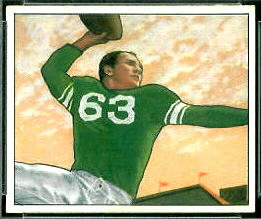 Ever wonder why all of the Baltimore Colts in the 1950 Bowman set are wearing green? Did Bowman take liberties with the team’s colors, as Topps did with the Houston Oilers in 1961? (See Houston Oilers: Pretty in Pink.) Did the team change colors from green to blue sometime after 1950?
Ever wonder why all of the Baltimore Colts in the 1950 Bowman set are wearing green? Did Bowman take liberties with the team’s colors, as Topps did with the Houston Oilers in 1961? (See Houston Oilers: Pretty in Pink.) Did the team change colors from green to blue sometime after 1950?
No, the 1950 Colts were actually a different franchise than today’s Colts. The original Colts were members of the AAFC, and they were one of three teams to join the NFL when the AAFC folded after the 1949 season. This Colts team lasted just one year in the NFL before disbanding, and in 1951 the Colts players were made available to the remaining teams via the draft.
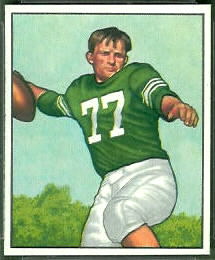 In 1953, the NFL awarded a Baltimore group a new franchise and gave it the remnants of the original Dallas Texans, a franchise that had lasted just one year in Dallas. The new Colts wore blue, and they’ve worn blue ever since. A nice article by Bob Carroll on the profootballresearchers.com web site traces the lineage of the two Colts franchises and the other AAFC teams.
In 1953, the NFL awarded a Baltimore group a new franchise and gave it the remnants of the original Dallas Texans, a franchise that had lasted just one year in Dallas. The new Colts wore blue, and they’ve worn blue ever since. A nice article by Bob Carroll on the profootballresearchers.com web site traces the lineage of the two Colts franchises and the other AAFC teams.
Pictured here are cards of two of the Colts cards in the 1950 Bowman set, Y.A. Tittle and Chet Mutryn. You can see the entire 1950 Bowman Baltimore Colts team set in the Vintage Football Card Gallery.
Here’s a bit of trivia: Besides Y.A. Tittle, what Hall of Fame quarterback played for the Colts in 1950?
Answer: George Blanda. The Bears traded Blanda and four other players to the Colts on September 5. Blanda played in one game for the Colts, and the Bears bought him back on September 20.
July 15th, 2010 |
Published in
Halls of Fame | 1 Comment
 Earlier this week, I listed the six members of the College Football Hall of Fame 2010 Divisional Class, who will be enshrined this weekend. They will be enshrined along with the eighteen members of the 2009 Bowl Subdivision (formerly Division 1-A) Class. You can see the full list of twenty-four enshrinees on the College Hall of Fame web site.
Earlier this week, I listed the six members of the College Football Hall of Fame 2010 Divisional Class, who will be enshrined this weekend. They will be enshrined along with the eighteen members of the 2009 Bowl Subdivision (formerly Division 1-A) Class. You can see the full list of twenty-four enshrinees on the College Hall of Fame web site.
The split between the Divisional Class and the Bowl Subdivision Class is a little confusing, since classes from different years are being enshrined together. Compounding the confusion, the 2010 Bowl Subdivision Class has already been chosen–before the 2009 class has been enshrined! The 2010 Bowl Subdivision Class, which was announced on May 27, 2010, will be inducted on December 7, 2010, and enshrined in 2011–together with the 2011 Divisional Class. In the meantime, the Hall of Fame itself is moving from South Bend to Atlanta, for more exposure. I suppose all of the annual events–two class announcements, two induction ceremonies, and the two-day enshrinement festival–are meant to maximize exposure, too.
At any rate, only one member of the 2009 Bowl Subdivision class appears on vintage cards. That’s Pervis Atkins, whose rookie card, a 1964 Philadelphia, is pictured here. Atkins played for six seasons with the Rams, Redskins, and Raiders. He also appeared on a 1965 Philadelphia card with the Redskins.
Here are the eighteen members of the 2009 Bowl Subdivision Class, along with some information on their cards. I don’t have many modern cards, so most of the links lead to examples on eBay.
| Player |
School |
Cards |
| Pervis Atkins |
New Mexico State, 1958-60 |
Atkins appeared on 1964 and 1965 Philadelphia cards, which you can see in the Vintage Football Card Gallery. |
| Tim Brown |
Notre Dame, 1984-87 |
Brown was a star in the NFL in the 90s, so there are a billion cards of him. I’m sure that modern card collectors already know this, but I learned today that one variation of his 1989 Score All Pro card pictures James Lofton. |
| Chuck Cecil |
Arizona, 1984-87 |
Cecil appeared on a few cards with the Packers. He is now the defensive coordinator for the Tennesee Titans. |
| Ed Dyas |
Auburn, 1958-60 |
Dyas was drafted by the Colts in 1961, but he did not play, and he did not appear on any cards. He instead became an orthopedic surgeon. |
| Major Harris |
West Virginia, 1987-89 |
Harris joined the Raiders after his junior year, but he never saw action for them. He did play professionally in the CFL, AFL, PSFL, and NMFL. He appeared on two 1990 Jogo CFL cards. |
| Gordon Hudson |
BYU, 1980-83 |
Hudson played one season for the Seahawks, and he did not appear on any cards. |
| William Lewis |
Harvard, 1892-93 |
If Lewis had played in 1894, he might have appeared in the first football card set, 1894 Mayo Cut Plug. Alas, he finished law school and did not play in 1894. |
| Woodrow Lowe |
Alabama, 1972-75 |
Lowe played eleven seasons for the Chargers, but he appeared on only three cards: 1980 Topps, 1986 McDonalds, and 1986 Kodak. |
| Ken Margerum |
Stanford, 1977-80 |
Margerum played six seasons for the Bears and 49ers. He appeared on 1982 Topps and 1986 McDonalds cards. |
| Dick MacPherson (coach) |
Massachusetts, 1971-77; Syracuse, 1981-90 |
MacPherson coached the New England Patriots in 1991 and 1992, and he appeared on a couple of 1991 cards. |
| Steve McMichael |
Texas, 1976-79 |
McMichael had a fifteen-year NFL career, most of it with the Bears. His rookie card is a 1985 Topps, and he appeared on ten or twelve cards after that. |
| John Robinson (coach) |
USC, 1976-82 and 1993-97; UNLV 1999-2004 |
Robinson was the head coach of the Rams from 1983 to 1991, and he appeared on a few 1990 and 1991 cards. |
| Chris Spielman |
Ohio State, 1984-87 |
Spielman had a ten-year NFL career with the Lions and Bills. He had three rookie cards–1989 Score, 1989 Pro Set, and 1989 Topps–and he appeared on numerous cards after that. |
| Larry Station |
Iowa, 1982-85 |
Station played one season for the Steelers, and he did not appear on any cards. |
| Pat Swilling |
Georgia Tech, 1982-85 |
Swilling played twelve seasons for the Saints, Lions, and Raiders, and he appeared on a lot of cards. His rookie card is a 1988 Topps. |
| Gino Torretta |
Miami (FL), 1989-92 |
Torretta played only a couple of games in the NFL, but he appeared on a few cards in his rookie season, 1993. |
| Curt Warner |
Penn State, 1979-82 |
Warner played eight seasons for the Seahawks and Rams, and he appeared on a lot of cards. His rookie card is a 1984 Topps. |
| Grant Wistrom |
Nebraska, 1994-1997 |
Wistrom played nine seasons for the Rams and Seahawks. He appeared on numerous cards in 1998, but none after that. |
 Last week, on my Facebook page, Pastor Scott asked if I knew if Fleer had planned a second series of football cards in 1963, since the 1963 checklist says “1st SERIES.” I told Scott that I had not noticed the label before, but that it was reasonable to surmise that Fleer had planned another series. Fleer printed two series in 1961–one of NFL players and one of AFL players–and perhaps the company had hopes of doing the same in 1963. (For more on Fleer’s early 1960s football cards, see F is for Fleer.)
Last week, on my Facebook page, Pastor Scott asked if I knew if Fleer had planned a second series of football cards in 1963, since the 1963 checklist says “1st SERIES.” I told Scott that I had not noticed the label before, but that it was reasonable to surmise that Fleer had planned another series. Fleer printed two series in 1961–one of NFL players and one of AFL players–and perhaps the company had hopes of doing the same in 1963. (For more on Fleer’s early 1960s football cards, see F is for Fleer.) Fleer wasn’t the only company that had football card plans grander than they could execute. As I wrote in N is for National Chicle, the backs of 1935 National Chicle cards say “one of 240 football players with playing tips,” but there are only 36 cards in the set. There were only eight pro teams at the time, so 240 cards would have covered practically every player in the league. As I said in the article, I suspect that the company planned to include college players and coaches in their set, as well.
Fleer wasn’t the only company that had football card plans grander than they could execute. As I wrote in N is for National Chicle, the backs of 1935 National Chicle cards say “one of 240 football players with playing tips,” but there are only 36 cards in the set. There were only eight pro teams at the time, so 240 cards would have covered practically every player in the league. As I said in the article, I suspect that the company planned to include college players and coaches in their set, as well.






















